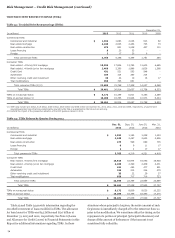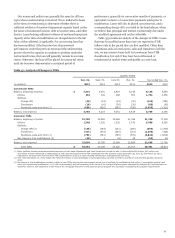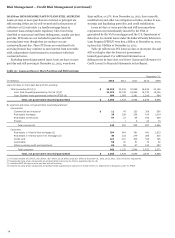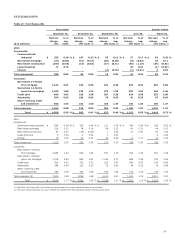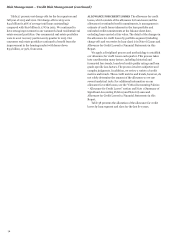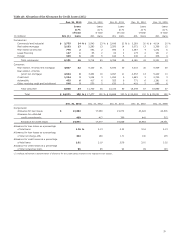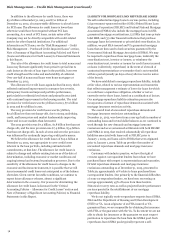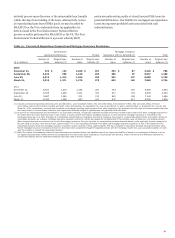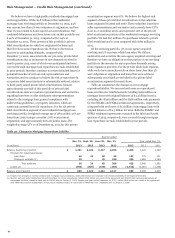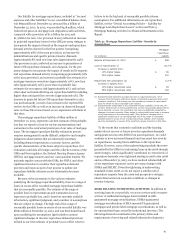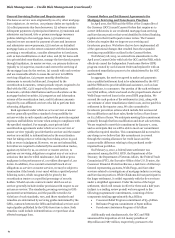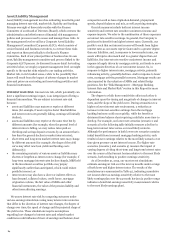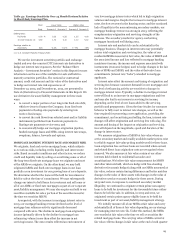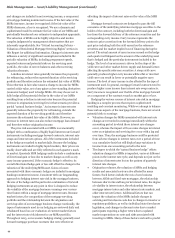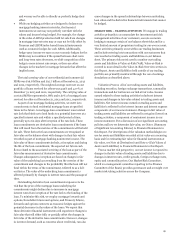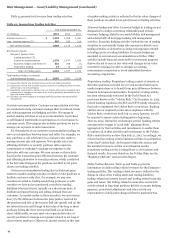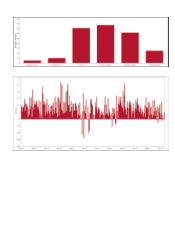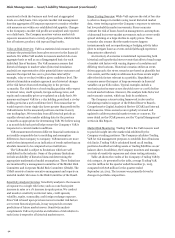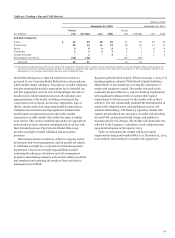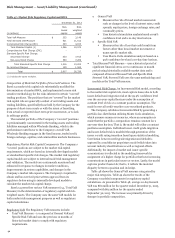Wells Fargo 2013 Annual Report Download - page 84
Download and view the complete annual report
Please find page 84 of the 2013 Wells Fargo annual report below. You can navigate through the pages in the report by either clicking on the pages listed below, or by using the keyword search tool below to find specific information within the annual report.
Risk Management – Credit Risk Management (continued)
General Servicing Duties and Requirements
The loans we service were originated by us or by other mortgage
loan originators. As servicer, our primary duties are typically to
(1) collect payments due from borrowers, (2) advance certain
delinquent payments of principal and interest, (3) maintain and
administer any hazard, title or primary mortgage insurance
policies relating to the mortgage loans, (4) maintain any
required escrow accounts for payment of taxes and insurance
and administer escrow payments, (5) foreclose on defaulted
mortgage loans or, to the extent consistent with the documents
governing a securitization, consider alternatives to foreclosure,
such as loan modifications or short sales, and (6) for loans sold
into private label securitizations, manage the foreclosed property
through liquidation. As master servicer, our primary duties are
typically to (1) supervise, monitor and oversee the servicing of
the mortgage loans by the servicer, (2) consult with each servicer
and use reasonable efforts to cause the servicer to fulfill its
servicing obligations, (3) prepare monthly distribution
statements to security holders and, if required by the
securitization documents, certain periodic reports required to be
filed with the SEC, (4) if required by the securitization
documents, calculate distributions and loss allocations on the
mortgage-backed securities, (5) prepare tax and information
returns of the securitization trust, and (6) advance amounts
required by non-affiliated servicers who fail to perform their
advancing obligations.
Each agreement under which we act as servicer or master
servicer generally specifies a standard of responsibility for
actions we take in such capacity and provides protection against
expenses and liabilities we incur when acting in compliance with
the specified standard. For example, most private label
securitization agreements under which we act as servicer or
master servicer typically provide that the servicer and the master
servicer are entitled to indemnification by the securitization
trust for taking action or refraining from taking action in good
faith or errors in judgment. However, we are not indemnified,
but rather are required to indemnify the securitization trustee,
against any failure by us, as servicer or master servicer, to
perform our servicing obligations or against any of our acts or
omissions that involve wilful misfeasance, bad faith or gross
negligence in the performance of, or reckless disregard of, our
duties. In addition, if we commit a material breach of our
obligations as servicer or master servicer, we may be subject to
termination if the breach is not cured within a specified period
following notice, which can generally be given by the
securitization trustee or a specified percentage of security
holders. Whole loan sale contracts under which we act as
servicer generally include similar provisions with respect to our
actions as servicer. The standards governing servicing in GSE-
guaranteed securitizations, and the possible remedies for
violations of such standards, vary, and those standards and
remedies are determined by servicing guides maintained by the
GSEs, contracts between the GSEs and individual servicers and
topical guides published by the GSEs from time to time. Such
remedies could include indemnification or repurchase of an
affected mortgage loan.
Consent Orders and Settlement Agreements for
Mortgage Servicing and Foreclosure Practices
In April 2011, the FRB and the Office of the Comptroller of
the Currency (OCC) issued Consent Orders that require us to
correct deficiencies in our residential mortgage loan servicing
and foreclosure practices that were identified by federal banking
regulators in their fourth quarter 2010 review. The Consent
Orders also require that we improve our servicing and
foreclosure practices. We believe that we have implemented all
of the operational changes that resulted from the expanded
servicing responsibilities outlined in the Consent Orders.
On February 28, 2013, we entered into amendments to the
April 2011 Consent Order with both the OCC and the FRB, which
effectively ceased the Independent Foreclosure Review (IFR)
program created by such Consent Order and replaced it with an
accelerated remediation process to be administered by the OCC
and the FRB.
In aggregate, the servicers agreed to make cash payments
into a qualified settlement fund to be administered by the OCC
and the FRB and to provide additional assistance, such as loan
modifications, to consumers. Our portion of the cash settlement
was $766 million, which was based on the proportionate share of
Wells Fargo-serviced loans in the overall IFR population. We
accrued the cash portion of the settlement in 2012, along with
our estimate of other remediation-related costs, and we paid this
settlement in first quarter 2013. We also committed to
foreclosure prevention actions which include first and second
lien modifications and short sales/deeds-in-lieu of foreclosure
on $1.2 billion of loans. We anticipate meeting this commitment
primarily through first lien modification and short sale activities.
We are required to meet this commitment by January 7, 2015,
and we anticipate that we will be able to meet our commitment
within the required timeline. This commitment did not result in
any charge as we believe that this commitment is covered
through the existing allowance for credit losses and the
nonaccretable difference relating to the purchased credit-
impaired loan portfolios.
On February 9, 2012, a federal/state settlement was
announced among the DOJ, HUD, the Department of the
Treasury, the Department of Veterans Affairs, the Federal Trade
Commission (FTC), the Executive Office of the U.S. Trustee, the
Consumer Financial Protection Bureau, a task force of Attorneys
General representing 49 states, Wells Fargo, and four other
servicers related to investigations of mortgage industry servicing
and foreclosure practices. While Oklahoma did not participate in
the larger settlement, it settled separately with the five servicers
under a simplified agreement. Under the terms of the larger
settlement, which will remain in effect for three and a half years
(subject to a trailing review period) we have agreed to the
following programmatic commitments, consisting of three
components totaling approximately $5.3 billion:
x
x
x
Consumer Relief Program commitment of $3.4 billion
Refinance Program commitment of $900 million
Foreclosure Assistance Program of $1 billion
Additionally and simultaneously, the OCC and FRB
announced the imposition of civil money penalties of
$83 million and $87 million, respectively, pursuant to the
82


